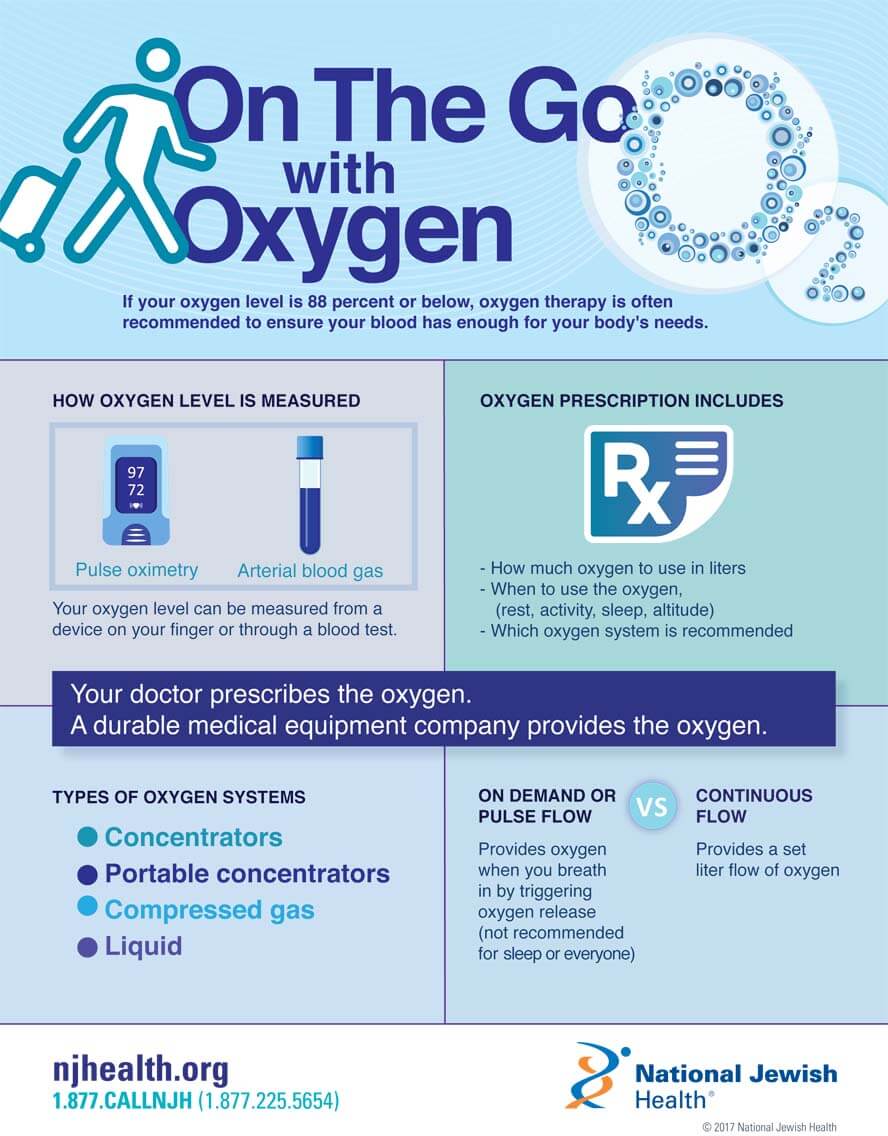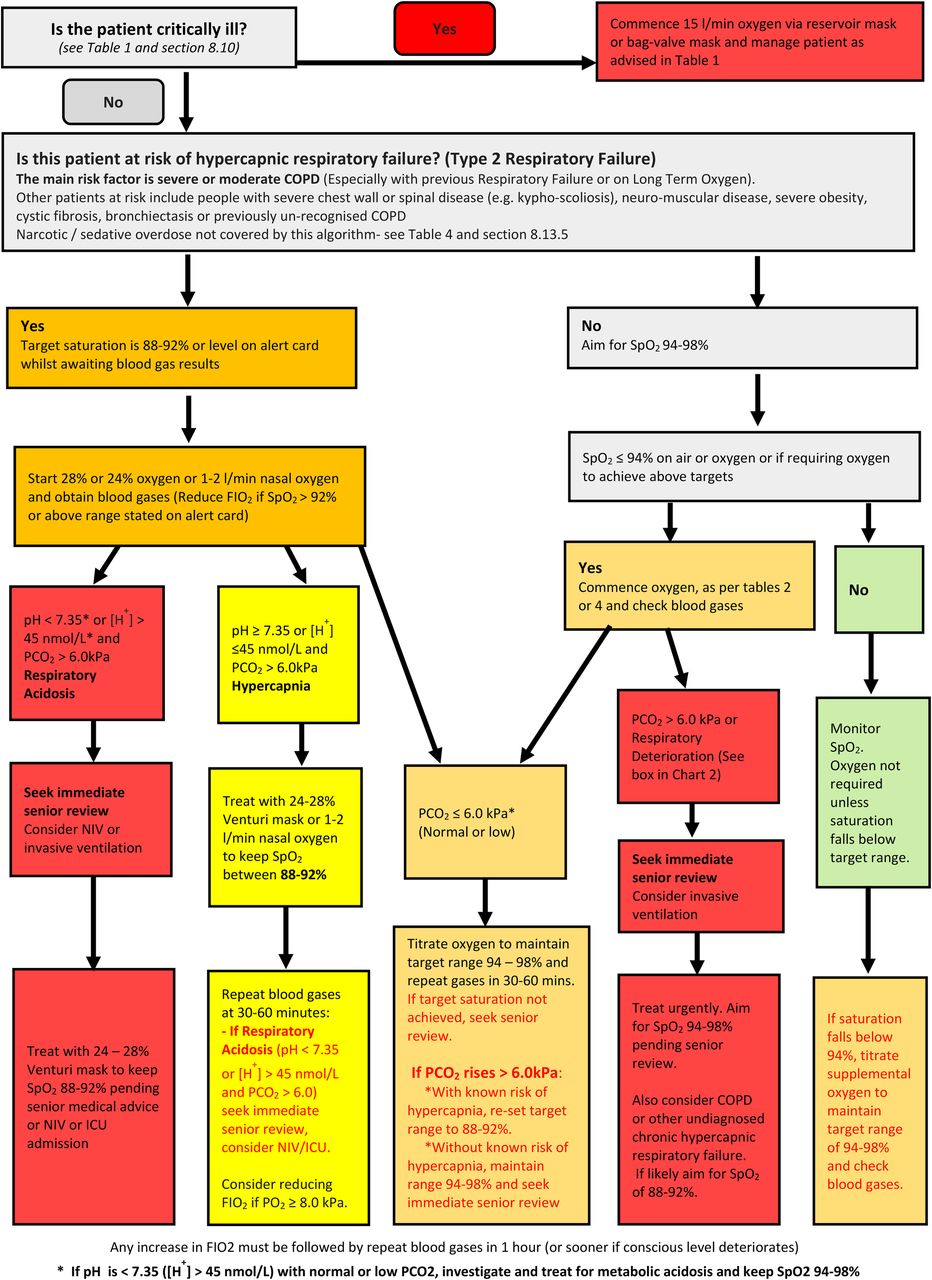One of the basic needs of every human body is an adequate supply of oxygen to all cells. Without this essential element to the heart and brain, you will die within six minutes. In a shorter period without oxygen, your body will begin to suffer consequences that may or may not be reversible. Take care when the blood oxygen is either too low or too high.
Hi Sharon, In order to be prescribed long term oxygen therapy (LTOT) the patient needs to have a resting partial pressure of oxygen (PaO2) of less than 55 mmHg and an oxygen saturation level lower than 88%. Normal and low blood oxygen levels Blood oxygen levels may be measured using a pulse oximeter. A normal blood oxygen level varies between 75 and 100 millimeters of mercury (mm Hg). What happens when your oxygen level drops to 60? An ABG test with a PaO 2 reading of 60 mmHg or below indicates an extremely low oxygen level. If your blood oxygen level is that low, you will probably need supplemental oxygen therapy. Supplemental oxygen therapy is a treatment that delivers oxygen gas for you to breathe. A problem with any of these factors — for example, high altitude, asthma or heart disease — might result in hypoxemia, particularly under more extreme conditions, such as exercise or illness. When your blood oxygen falls below a certain level, you might experience shortness of. Hypoxemia occurs when levels of oxygen in the blood are lower than normal. If blood oxygen levels are too low, your body may not work properly. Blood carries oxygen to the cells throughout your body to keep them healthy. Hypoxemia can cause mild problems such as headaches and shortness of breath.
What Is Blood Oxygen?
The chemical element oxygen is a small but important part of the atmosphere. Critical for human health, the oxygen level in the blood is usually strictly controlled by the human body. The normal concentration or level of oxygen in the blood is usually defined as over 95% when breathing room air. With a blood oxygen level less than 88%, most people will begin to notice symptoms.
Low Blood Oxygen Level
A low blood oxygen level, also called hypoxemia, is defined as an oxygen level in the blood that is lower than normal. The lower limit of normal is typically defined as 90%. The level of oxygen in your blood is determined by measuring how much oxygen is in a sample of arterial blood.
Symptoms
Common symptoms of low blood oxygen may include shortness of breath and fatigue NOT associated with exercise. You may also notice that you are not able to exercise as you normally would. In severely low oxygen, you may become confused and be unable to communicate clearly.

Causes
Causes of low blood oxygen levels may be environmental, medication induced, or due to another medical condition. The most common causes of low blood oxygen are medical conditions including: certain heart defects, chronic lung disease, pneumonia, pulmonary edema, pulmonary embolus, anemia, and acute respiratory distress syndrome. High altitude and sleep apnea can also lead to decreased oxygen levels.
Home Remedies
- Quit Smoking. If you smoke, stop now. Smoking is a known cause of lung disease that can lead to low oxygen levels.
- Avoid Passive Smoking. Studies over the last several years seem to show that secondhand smoke is as bad or worse than smoking yourself. Avoid areas where others are smoking. Make your environment a smoke-free one.
- Take Regular Exercise. Regular exercise will help your body develop efficient oxygen transport mechanisms. If you currently suffer from low blood oxygen, work with your doctor or physical therapist to develop an exercise routine that is right for you.
When to See a Doctor
Oxygen Level 88 When Sleeping
You should see a doctor if you develop shortness of breath, cough, headache or other symptoms that do not resolve when you rest. If you have shortness of breath during sleep or if shortness of breath seems much worse than normal with only minimal exertion, be sure to see your healthcare provider as soon as possible.
High Blood Oxygen Level
Hyperoxemia is a serious condition in which the oxygen level in the blood is extremely high. Usually experienced by scuba divers or astronauts, this condition may also be seen in patients who are being treated with hyperbaric oxygen therapy.
Symptoms
Symptoms of high blood oxygen levels usually start with visual disturbances followed quickly by confusion and disorientation. In very severe cases, hyperoxemia can lead to seizures and brain damage.
Prevention Measures
Scuba divers and astronauts must undergo training to recognize and prevent this problem. Any patient undergoing hyperbaric oxygen treatments is continuously monitored to prevent blood oxygen levels that are too high.
Warnings
Blood oxygen levels must be maintained within a certain range to avoid health problems associated with levels that are too high or too low. Oxygen levels that are not optimal can lead to irreversible damage in the human body.
Doctors will often monitor your oxygen levels. These can be monitored by using a pulse oximeter. You can monitor your own oxygen levels at home by purchasing your own pulse oximeter. Still, what is the best way of interpreting your oxygen levels? What do they mean? Here’s what to know.
What is partial pressure of arterial oxygen (PaO2)?
This is the most accurate oxygen level that we monitor. It’s how much oxygen is inside your arterial blood. A perfect reading would be 104. However, anything between 80-100 is considered acceptable. A PaO2 of 60-79 is considered mild hypoxemia. A PaO2 of 40-79 is considered moderate hypoxemia, and a PaO2 of less than 40 is considered severe hypoxemia.
Hypoxemia is a fancy term for a low arterial blood oxygen level. Most experts accept the PaO2 value of 60 as the baseline value we want to maintain. If COPD is causing a PaO2 of less than 60, supplemental oxygen is indicated. Usually, with COPD, all that is needed is a low flow of 2-3 LPM. This is usually all that is needed to maintain a PaO2 of 60 or better. If you want, you can read my article, 'How To Qualify For Home Oxygen Therapy?'
There is only one way to learn what your PaO2 is. It is to draw blood from one of your arteries. The artery we usually draw it from is the radial artery. This is an artery that is near the surface on the thumb side of the back of your wrist. This test is called an Arterial Blood Gas (ABG). This is an invasive blood draw.

What is oxygen saturation (SpO2)?
SpO2 is another oxygen level. It’s the percentage of oxygen molecules you inhale that make it to your arterial blood. A perfectly normal value is 98%. However, anything greater than 90% is considered acceptable. For some people with COPD, doctors consider anything between 88-92% to be acceptable.
This value is determined using a pulse oximeter. It’s a small, hand-held device that you slip over a finger, toe, or earlobe. You can purchase these in stores. The ones you buy for your home are usually ones that slip over your finger.
These devices can be purchased for less than $30. You can get them from online stores like Amazon. I have seen them at stores like Aldi. The trick here is that you will want to make sure the one you buy is FDA approved. This will ensure that you are getting an accurate reading.
How are pulse oximeters helpful?
Oxygen Level 88 Percent
Pulse oximeters are helpful because they offer a simple, noninvasive way of determining your oxygen level. But your SpO2 level can also help determine your PaO2. This is by means of the 4-5-6-7-8-9 Rule.
Normal Blood Oxygen Level
It goes like this.

- 40 PaO2 equals an SpO2 of 70%
- 50 PaO2 equals an SpO2 of 80%
- 60 PaO2 equals an Spo2 of 90%
Basically, you take your SpO2 value minus 30. This gives an 'estimate' of where your PaO2 stands. By doing my own experiments, I have determined this 'estimated' PaO2 to be pretty accurate.
So, if your pulse oximeter gives you a reading of 90%, this means that your estimated PaO2 is 60. That’s right about where we want it. This is why the hospital I work for has a policy of maintaining a SpO2 of 90%. There are some exceptions that we can discuss in a future post if you want.
A helpful tool
Pulse oximeters are nice. They allow you and doctors to monitor your oxygen level at pretty much any time and place. It’s simple, painless, and accurate as long as you have a pulse oximeter that is FDA approved. You should talk to your doctor about determining what SpO2 level is best for you. For most people, it’s 90% or better. However, with some people with COPD, 88% is acceptable too. To learn what oxygen levels are best for you, talk to your COPD doctor.

Article
4 Amazing Benefits of Home Oxygen Therapy
Article
Oxygen Level 88 Means
The Do's and Don'ts of Using Supplemental Oxygen at Home
